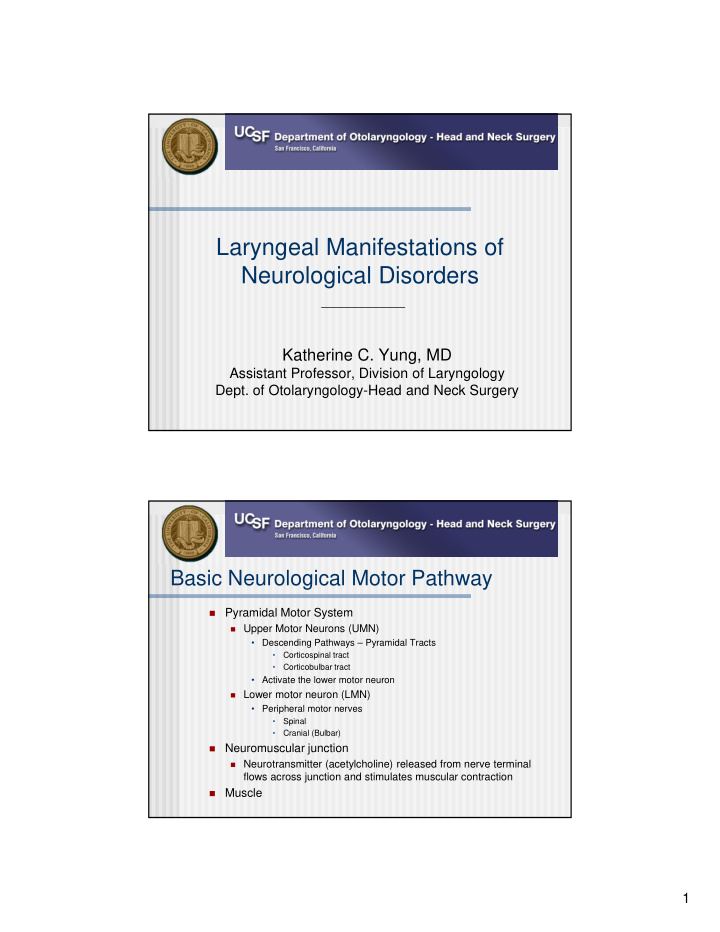



Laryngeal Manifestations of Neurological Disorders Katherine C. Yung, MD Assistant Professor, Division of Laryngology Dept. of Otolaryngology-Head and Neck Surgery Basic Neurological Motor Pathway Pyramidal Motor System Upper Motor Neurons (UMN) • Descending Pathways – Pyramidal Tracts • Corticospinal tract • Corticobulbar tract • Activate the lower motor neuron Lower motor neuron (LMN) • Peripheral motor nerves • Spinal • Cranial (Bulbar) Neuromuscular junction Neurotransmitter (acetylcholine) released from nerve terminal flows across junction and stimulates muscular contraction Muscle 1
Neuroanatomic pathways Symptoms suggesting Neuropathology Speech Dysarthria, hypernasality, abnormal resonance Voice Asthenia, breathiness, instability, strain Swallowing Oral incompetence, aspiration, nasal regurgitation, inability to initiate swallow 2
Clinical Assessment Basic head and neck exam, including cranial nerves Special attention to: Facial and lateral jaw movements Tongue fasiculations Tongue strength Coordination of tongue movement Laryngeal elevation with swallow Velar function Clinical Assessment Perceptual speech and voice evaluation Laryngeal Exam Vocal fold motion Pharyngeal wall motion Consider: FEES or MBS 3
Extrapyramidal Neurologic System System of nerve tracts and pathways connecting the cerebral cortex, basal ganglia, thalamus, cerebellum, reticular formation, and spinal neurons in complex circuits not included in the pyramidal system Responsible for coordinated reflex interactions Affects motor function by either facilitation or suppression Extrapyramidal Neurologic System Voice Hypotonic – flaccid Hypertonic – constricted Speech Spastic Ataxic Breathing Vocal fold dysfunction (paradoxical motion) Swallowing Impaired if associated with significant muscular weakness 4
Associated Symptoms FAILURE TO FAILURE TO SUPPRESS FACILITATE Tremors Bradykinesia Chorea Diminished postural responses Athetosis Dystonia Myoclonus Spasmodic Dysphonia Voice Increased effort Unreliable in different situations (Stress) Whisper is normal Maybe able to sing Abductor and Adductor varieties • Patients usually aware of words and situations which make voice worse Swallowing - Uninvolved 5
Spasmodic Dysphonia Spasmodic Dysphonia 6
Vocal Tremor Voice Tremor Strain/roughness Often deny effort associated with SD Not sound specific Swallowing Unaffected Tremor 7
Parkinson’s Disease Voice Weak with early fatigue Breathy - soft Pitch elevated Speech “mumble” Swallowing – potential problems late in disease Parkinson’s Disease 8
Multiple System Atrophy Shy-Drager syndrome Progresses more quickly than PD Autonomic dysfunction Parkinsonism Ataxia Stridor and dysphagia Multiple System Atrophy 9
UMN Pathway Disruption Spasticity spastic dysarthria spastic dysphonia Swallowing and other vegetative functions- relatively well preserved until disruption is severe Swallowing - Inability of UES to relax Breathing - Inability of vocal folds to relax to produce voice or allow inspiration UMN Pathway Disruption 10
LMN Pathway Disruption Flaccidity flaccid dysarthria flaccid dysphonia Swallowing and other vegetative functions are affected early Dysphagia to liquids Breathing – impaired due to lack of abduction LMN Pathway Disruption 11
Associated Signs & Symptoms Upper motor: spasticity, hypertonia, hyperreflexia, clonus, Babinski sign Lower motor: flaccidity, hypotonia, hyporeflexia, atrophy, fasciculations (usually for motor neuron disease only) Site of Lesion Extrapyramidal disorders Parkinson’s disease Cerebellar stroke Spasmodic dysphonia Tremor Upper motor neuron disorders Stroke Pseudobulbar palsy Primary lateral sclerosis (PLS) 12
Site of Lesion Lower motor neuron Brainstem stroke (e.g. lateral medullary syndrome) Myasthenia gravis Guillain-Barre ’ Polio (post-polio) Mixed TBI Motor Neuron Disease • ALS • Progressive Bulbar Palsy Motor Neuron Disease Type UMN LMN degeneration degeneration ALS yes yes PLS yes no PMA no yes Progressive no yes - bulbar bulbar palsy region Pseudobulbar yes - bulbar no palsy region 13
Chen and Garrett 2005 Motor Neuron Disease in the Otolaryngology Clinic 1759 patients presented with voice, speech and swallowing complaints 15/1759 diagnosed with ALS Referring diagnoses included • Unknown neurological disease • GERD • Stroke • Bowing • SD • Polyp Typical time between initial ENT visit and accurate diagnosis was 6 months 220 patients diagnosed with MND in Neurology clinic 44/220 presented with bulbar signs (dysarthria, dysphagia, dysphonia) 19/44 initially presented to otolaryngologist 8/19 neuromuscular disease was missed initially by ENT Chen, A, Garrett CG. Otolaryngol Head Neck Surg. 2005 Mar; 132 (3):500-4. Treatment Options Relief of Spasticity 14
Treatment Options Relief of Spasticity - PLS Treatment Options Improvement of Glottic Closure 15
Spasmodic Dysphonia Parkinson’s Disease 16
Role of the Otolaryngologist Acute observation of the presenting signs and symptoms Knowledge of the corresponding neuroanatomy and possible disease states Expedient referral to appropriate neurological evaluation Primary management Airway safety Other disorders of head and neck – atrophy, spasticity 17
Recommend
More recommend